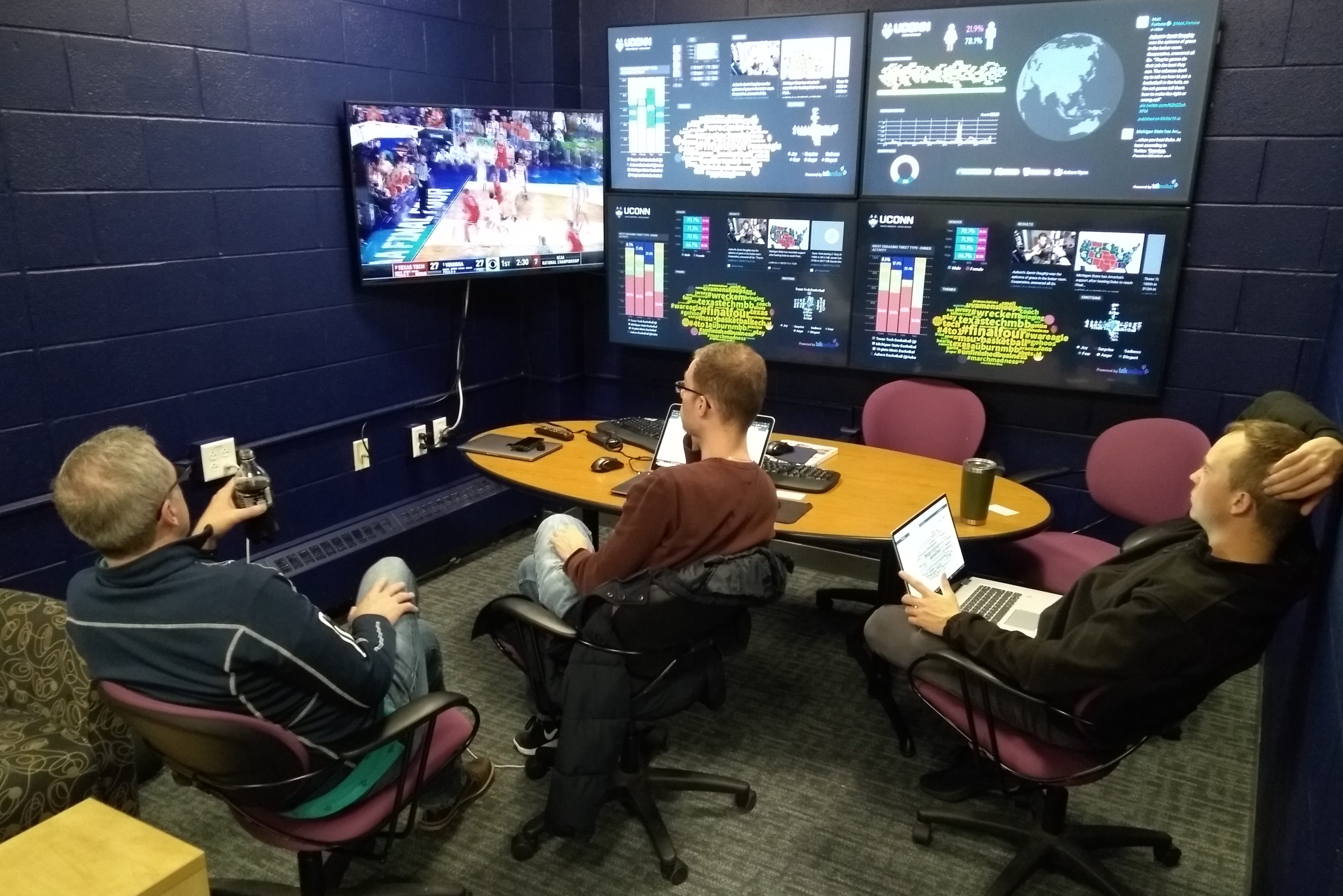Last spring on the night of the 2019 NCAA Men’s Basketball Championship, Blake Kelley and Matt Barry spent the evening much like many other college students: watching the game to see whether Texas Tech or the University of Virginia would win the title.
However, the two seniors in the Digital Media and Design (DMD) department in the School of Fine Arts were in the DMD Social Media Analytics Command Center (SMACC) in Merlin D. Bishop Center joined by their professor, John Murphy, assistant professor in-residence for Digital Media Business Strategies. All three simultaneously kept a close eye on four large computer monitors adjacent to the television screen with the game broadcast.
The four additional screens were set up to follow the worldwide social media platform response to the game – word bubbles, demographics of responders, viewership by nation, viewership by state in the U.S., fan bases for each team, top emojis, topics and themes for the night and top hashtags by mention. All of the information is derived from public sources.
The two students and their professor chatted periodically about what they observed before posting some of their information on the UConn SMACC Channel, where others can see their work. Last year DMD students tracked the mid-term U.S. election and the Oscars, among other events.
By halftime of the game, social media response reached 37.2 billion on all forms of digital media, from Twitter and Facebook to You Tube and blogs. Early in the game Texas Tech fans dominated social media conversation as their team narrowed an early deficit. After the game went into overtime and Virginia went on an 11-0 run to win, Wahoo fans expressed joy over the internet, while Red Raiders fans expressed anger.
Murphy says tracking and analyzing social media activity in real-time is helping to better monitor, engage and amplify those social media conversations around brands, markets, products or influencers. This is the newest tool in the world of branding and marketing.
“When social media began eight years ago, people would have a great idea, quote unquote. Let’s do this type of campaign on this [social media] channel. We’ll go on Facebook and throw a lot of pictures on there,” he says. “Besides some high value vanity metrics like how many likes they got, they didn’t really know if it was successful. Now with social media ingrained in every company’s marketing strategy and the budgets getting higher, the pressure is on from the people who approve the budget to demonstrate it’s a good idea before giving you money for a social media campaign. Then while you execute the campaign, prove it’s working.”
An example of the immediate power of social media was evident during the basketball game broadcast when Kansas City Chiefs quarterback Patrick Mahomes, a former Texas Tech player, was shown at the game. His more than 517,000 followers on Twitter caused a spike on social media platforms that was evident in the tracking on the Bishop Center computer monitors. When media organizations such as ESPN or CNN send out messages on news activity, social media branches also out in various forms, such as re-tweets from followers on Twitter. ESPN’s Twitter page currently shows 34.2 million followers.
In a “March Madness Social Review” report that Murphy, Barry, and Kelley produced after gathering other information following the game broadcast, they noted that both television viewership and social media engagement by fans was lower in large U.S. markets than in most previous years. Twitter dominated social media, with nearly 72% of activity, followed by 14.6% using online media and 5.6% writing on blogs.
“The social media activity for the game was quiet for most of the night,” they noted. “The biggest spike of engagement came at 11:45 p.m. – the end of the game.” Murphy, who previously led social media activities and both Cigna and Aetna, says people-to-people communication has overtaken the pervious business-to-business model of connecting consumers to companies and their products.
“If you’re the chief executive of a company, you’re a person. You’re on social media. When we’re at home, we’re on social media,” Murphy says. “Companies are marketing to us all the time. No one’s marketing to UConn or Pratt & Whitney. They’re marketing to people.”
Digital Media and Design students focusing on business strategies are learning how to understand the way digital media technology affects consumer behavior and how businesses and organizations are integrating the technology into their operations. They also have the opportunity to work experience real-world digital marketing challenges by working on projects with small businesses and nonprofit organizations seeking assistance from SMACC.
“We want to train the student, and at the same time add new value using a new technology that no other university has and is leveraging the way were are,” Murphy says. “We want to accomplish both those things. We want to monitor and measure all social media data such that the people-to-people marketing, crisis management or content optimization can be supported by data versus just ideas. That’s around the world of analytics.”
Murphy and his students are currently working in the areas of sports merchandise, jewelry, mental health organizations and advertising agencies as well as pending agreements with the casino industry.
Barry also has been working with UConn Athletics to develop a series of social channels to show the life of student-athletes off the field of play.
“We have developed series of social channels that showcase content focused on the student athlete perspective as well as the stories of UConn sports history,” he says, noting that there are 13 students from both Digital Media and Athletic Communications collaborating on developing the content for what is known as “The Pound.”



